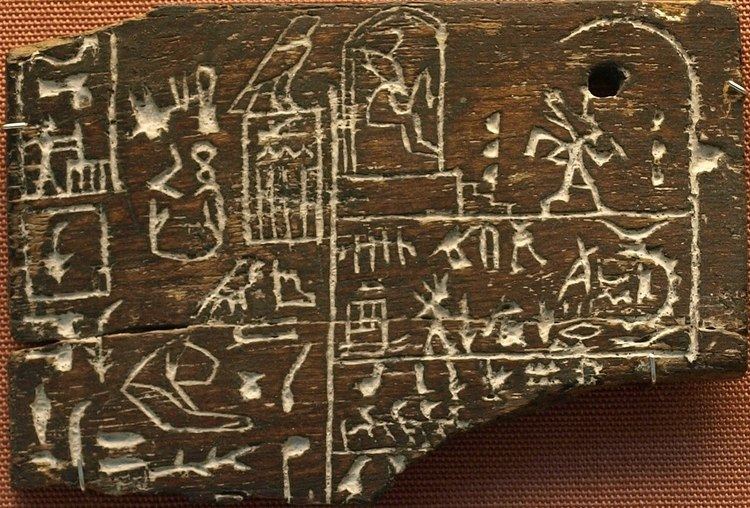 | ||
The ancient Egyptian Branch hieroglyph, also called a Stick, is a member of the trees and plants hieroglyphs.
Contents
- Pharaonic usage
- Old Kingdom usage
- Rosetta Stone usage of branch khet
- Ramses II at Abu Simbel
- Block statue of Bakenkhonsu
- References
The branch is an Egyptian language biliteral with the value (kh)t, (khet)-(ḫt); it is an ideogram-(determinative), for wood, tree, and the linear measure (=100 cubits). The hieroglyph is described as a branch without leaves.
Pharaonic usage
Pharaoh Nectanebo II used the branch hieroglyph for his Nomen name of Nakhthoreb, "Strong is His Lord, Beloved of Hathor".
Pharaoh Nectanebo I's nomen was Nekhtnebef, "Strong is His Lord."
Old Kingdom usage
Two labels are known from the Old Kingdom showing usage of the branch hieroglyph, one by Pharaoh Den, one by Semerkhet. The usage on the labels shows the branch hieroglyph in a more archaic form.
Rosetta Stone usage of branch--"khet"
In the 198 BC Rosetta Stone the branch hieroglyh is used six times, lines R1 combined with N23-(the Nubayrah Stele), R5, R6, R9, R13 and R14.
The Rosetta Stone usage of the hieroglyph is somewhat distinctive:
Ramses II at Abu Simbel
A wall relief inside the Great Temple of Abu Simbel shows Ramses II smiting Libyans. Young Ramses in a chariot is shown on the left, bow drawn, charging into Syrian ranks. On the right he is standing over one prone Libyan fighter, and is smiting another with a mace-club in his right hand, while holding the Libyan fighter with his extended left arm. The extensive military scenes are commemorating his military victories, and the hieroglyphic text explains the specifics of the events.
Above the clasped Libyan fighter is one column of text, (out of a series of about 15 columns, variable in height), describing the "victory-buildings", the strongholds that the captives will be confined in. The text explains that Ramses and the Egyptian army went after three groups of rebels, and then confined them.
Block statue of Bakenkhonsu
Ramesses II's 1st Order priest Bakenkhonsu, a High Priest of Amun-Ra of the 13th century BC has a nearly undamaged block statue. The statue presents four columns of hieroglyphs on its frontal face, and a horizontal inscription on the plinth. The vertical texts of hieroglyphs cover about fourteen vertical compositional blocks. (see here [2])
The first column addresses the gods: Amun-Ra, Tem-(Atum), then Horus, Mut and Khonsu. Column 2 uses the branch hieroglyph to state the title he assumes. The sentence starts as follows:
"...Title permanent in Uas-t, DjedU, "Strength (of) Eternity" by Soul of Ra-forefront, Emeer-(governor), (of) God-Priests..."